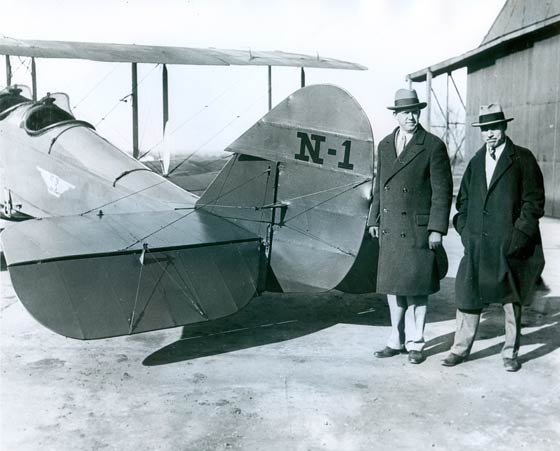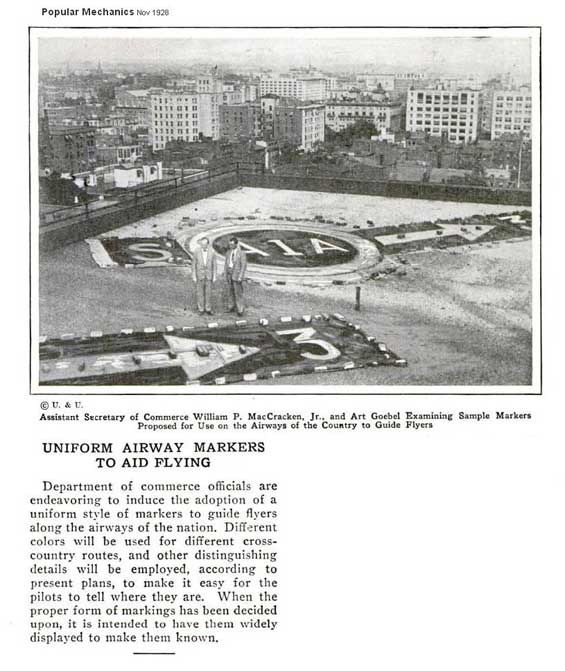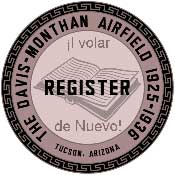|
Clarence Young was educated as a lawyer, attending Drake University and graduating from Yale law school. He was a decorated veteran of WWI, piloting a trimotored Caproni bomber on the Italian front. He was shot down and spent five-months as a prisoner of war in Austria. After WWI, like many "unemployed" pilots, he purchased a "Jennie" and barnstormed. With the coming of the mid-1920s, he extended his expertise in aviation several steps further.
Following the passage of the Civil Aeronautics Act in 1926 (see Clover Field Register pilot Hiram Bingham for additional information), Young quickly moved up the Federal administrative ranks. He was the Director of Aeronautics, U .S . Dept . Commerce (DOC), 1926-29. He became Assistant Secretary of Commerce for Aeronautics (1929-33) under President Hoover. As such, he was instrumental in building the early aviation infrastructure in the Continental United States, with branches that reached internationally. A very insightful oral history is at the link. As you read through it, you will note that Young was in the right place at the right time, with the right credentials, to play a leading role in the growing United States aviation industry.
His oral history is important, as it details some of the very earliest planning for aircraft airworthiness criteria and pilot certification. Another way of saying this is that his oral history documents, informally and in the first-person, where and how our fundamental U.S. air regulation began. Where we are today, with respect to airways, aircraft identification numbers and pilot and mechanic certification criteria, all had their foundations in the work of Register pilot Young and the Federal organizations he headed.
Below, shared with us by friend of dmairfield.org, John Underwood, a photograph of Clarence Young (R), with his boss William McCracken (1865 - 1938, see below). While not signed in the Register, McCracken was a prominent fellow lawyer in Chicago, and also the secretary of the American Bar Association. He was assigned to be the first Assistant Secretary of Commerce for Aviation. A similar image appears among the Hagley Museum and Library Collection (note that it is not the SAME photograph: their hands are in different positions). Regardless, the Library estimates the photo date as January 6, 1927. The subject is the first airplane with a federal registration number. The assignment of registration numbers to aircraft was part of Young's job as Director of Aeronautics. The photograph was taken at Bolling Field, Washington, DC.
Clarence Young (R) with William McCracken and N-1, A deHavilland DH-4B, Location Unknown (Source: Underwood)
 |
"N1" today is a 1990 Gulfstream G-IV, operated, coincidentally, by the FAA's National Flight Program Oversight Office.
While Young handled aircraft, McCracken handled airways, as the photo below suggests. There, he stands with Register pilot Art Goebel to review samples of proposed airway markings to guide aircraft from the ground. These samples were set up on a rooftop and weighted with blocks.
Wm. McCracken (L) & Art Goebel, 1928 (Source: Bybee)
 |
Clarence Young signed the Register at Tucson twice. On Tuesday, April 19, 1927, he arrived in the morning in NS-4, an aircraft identified as a Buhl. He carried passenger Walter F. Parkin westbound from Washington, DC to Los Angeles, CA. They stated in the Remarks column of the Register, "Enroute to New Station." The "NS" prefix on the airplane registration signifies that it was operated by the DOC. The "new station" remark perhaps refers to the fact that Young had been recently appointed Chief of the Air Regulations Division of the Government's new Aeronautics Branch in the Department of Commerce.
In California at this time, he personally inspected the "Spirit of St. Louis" and appoved its registration and Charles Lindbergh's pilot license. The oral history cited above quotes Young on page 13:
| "Someone in the [Ryan] factory reminded Charlie [Lindbergh] that under the new regulations it would be necessary for him to have the airplane licensed and also to get a pilot's license for himself. Apparently he had been too busy with other things to give these matters attention . When his plane was out of the factory and ready for flight testing, I was in Los Angeles and decided to go down to San Diego to see if I could be of any assistance to him in getting the license matter straightened out." |
Young also oversaw the preparations and departure for the Dole Race in August, 1927. See the details of the Dole event in the book cited in the left sidebar, and at Register pilot Art Goebel, who won that race along with his navigator, William V. Davis, Jr.
His second visit at Tucson was over a year later, on Sunday, September 2, 1928. He was solo in Stearman NS-17, westbound from El Paso, TX to Los Angeles. Young held pilot's license #2 (see below). In January the following year, the Department of Commerce received the Collier Trophy. The award was cited in the Navy's Bureau of Aeronautics Newsletter (February 20, 1929, reprinted from Domestic Air News #45)) as follows.
Bureau of Aeronautics Newsletter, February 20, 1929 (Source: Webmaster)
 |
As further testimony to his work, Young appeared on the cover of Time Magazine, March 14, 1932, which stated that Young's aviation "domain" at the time consisted of, ".... a network of dark lines [which] traces 21,764 mi. of airway. Scattered white pins mark the nation's 2,034 airports. Lighted emergency landing fields stand out as 382 green pins while 53 blue pins designate radio beacons, 1,567 red pins, rotating beacon lights, 386 nickel pins, acetylene blinkers." A similar map constructed today would be considerably more cluttered with lines and pins. Interestingly, Young's Director of Licensing and Inspections was Register pilot Gilbert Budwig.
Time further describes Young and his role as Assistant Secretary for Aeronautics. This is a long quote, but I think it combines a sense of the early accomplishments of Young and his Bureau of Aeronautics with the stilted journalistic style of the day. It also explains why he carried pilot certificate #2, the second one ever issued by the federal government.
| ".... As he sat in his office last week Col. Young thumbed through two new volumes which reported the 1932 state of the Air Empire represented on the map and of the industry that lives in it. The volumes were The Aircraft Year Book for 1932 compiled by the Aeronautical Chamber of Commerce* and the annual statistical number of Aviation, edited by Edward Pearson Warner, onetime Assistant Secretary of the Navy for Aeronautics. The information in the volumes was not all new to Col. Young, because his department had supplied much of it. But together they set forth aeronautical facts & figures which gave Col. Young and the public-at-large a quick bird's-eye view of U. S. aviation. Prime facts & figures:
"Civilian & commercial airplanes flew approximately 145,000,000 mi. last year, a decrease of about 20,000,000 mi. from 1930. The decrease was accounted for by a decline in private flying and such miscellaneous air activities as sightseeing, instruction, and photography. Scheduled air transport continued to boom, but not so much as in recent years. For the first time since 1925 it failed to double its previous year's record for passenger-mileage. Nevertheless it was up some 20% in a year when railroad and steamship travel slumped heavily. Transport planes carried 457,800 passengers, flew 43,400,000 mi.
"On only about 25% of the airways are passengers offered services of more than two round trips per day. On only about 1,200 mi. in scattered sections is there anything like high-frequency passenger service. Average passenger fare is 6.53¢ per mi. against 7.4¢ a year ago.
"The transport safety record gave great promise at midyear but accidents finally rose from 91 in 1930 to 126 in 1931. Eleven pilots were killed, 26 passengers. Result: Transport planes flew 375,000 mi. per accident, against 400,000 the year before.
"Hard times reduced the number of companies manufacturing planes from 215 to 110, of which only about 40 were in active production last year. The value of all aircraft, engines and parts sold, fell from $53,466,000 to $49,097,000. Significantly military sales accounted for two-thirds of the 1931 business.
"The Chief. Like the two other Assistant Secretaries for Aeronautics, War's Frederick Trubee Davison and Navy's David Sinton Ingalls, Clarence Young was graduated from Yale (1910). He practiced insurance law in Iowa, his home state, until the U. S. entered the War, when he became pilot of an Italian bomber. Shot down over the Austrian lines by an anti-aircraft shell which flopped his big plane upside down. Pilot Young was a prisoner of war until he escaped to Italy in a box car. Back again in Iowa he organized the first company to sell Wartime 'Jenny' planes, disposed of 50 at $5,000 each. Also he ran a flying school, went barnstorming, had his share of crack-ups from occasional foolhardiness. After directing the aviation program at the Philadelphia Sesquicentennial Exposition (1926) he was appointed Chief of Air Regulation under William Patterson MacCracken Jr., the first Assistant Secretary of the Commerce Department's newly formed Aeronautics Branch. In that capacity he issued to Mr. MacCracken Pilot's License No. 1 after Orville Wright had modestly declined it because he no longer flew. Col. Young received in turn No. 2. When Assistant Secretary MacCracken resigned in 1929 there was no doubt in anyone's mind as to who knew most about his job. Pilot Young was promptly appointed.
"Today Col. Young enjoys enormous popularity in the industry and practically universal respect. Utterly conscientious in administering his job, he is incapable of political ballplaying. Many a manufacturer school director or transport operator has learned that "The Chief" may submit to being called by his first name, but is quick to meet each & every request for an easy or lax interpretation of Government rules with: 'The Air Commerce Act says 'No!''
"No swivel-chair administrator, Assistant Secretary Young traveled 30,000 mi. last year, boarded a train only twice. Mostly he journeys in the Department of Commerce Ford NS-1 which, equipped in club-car fashion with a desk and radio headphones in the cabin, serves as his flying office and from which every detail of airway construction, maintenance, lighting and radio weather-reporting can be observed first hand. Only touch of elegance in the cabin is a brilliant maroon felt pillow with the seal of the Aeronautics Branch (a beacon over which flies the original Wright Brothers' plane) on one side; on the other the name of Clarence M. Young in orange letters. The pillow was the gift and particular pride of Col. Young's pilot, plump John Cable. In one or another of the Department's planes the Colonel still puts in enough hours of actual piloting to keep his transport license and reserve commission active.Col. Young works long hours. The golf sticks which he took to Washington with him three years ago have never been out of their bag. Tall, bronzed, 42, much less social than the other flying assistant secretaries, he is not married, lives alone in the Hay-Adams House across Lafayette Square from the White House. He smokes cigarets furiously, curses lustily." |
Although unmarried at publication of this Time article, he married actress Lois Moran (b. Pittsburgh, PA; d. Sedona, AZ July 13, 1990) on February 10, 1935. They had one son, Timothy Marshall Young.
From his obituary in the April 11, 1973 Flagstaff (AZ) Sun (courtesy of Mike Gerow), in 1956 Young was presented the Elder Statesman of Aviation Award by the Board of Directors of the National Aeronautic Association, "... in recognition of his significant and enduring contributions over the years in the progress of aeronautics." He retired in 1959 as executive vice president of Pan American World Airways. He moved to Phoenix in 1966 and to Sedona, AZ in 1969. Born July 24, 1889, Young flew West on April 10, 1973.
---o0o---
THIS PAGE UPLOADED: 03/16/10 REVISED: 03/30/10, 03/31/11
|




